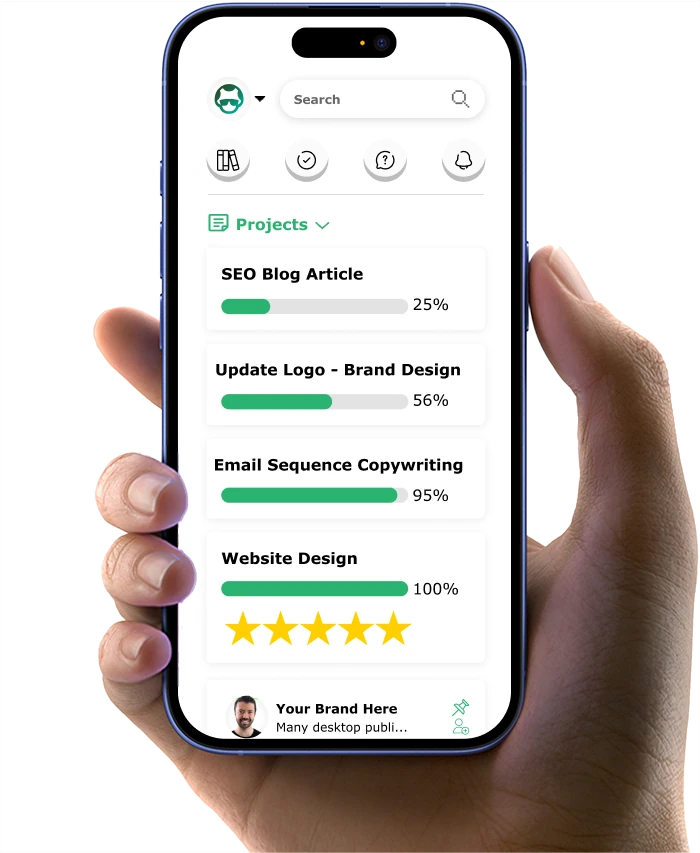Professional Headers: 11 Steps to Get More Leads

Ever visited a website and had no idea what services they actually offer? That's the problem with unclear service headers. Learning how to write clear service headers is one of the simplest yet most powerful ways to improve your website's performance.
Your website has less than a second to make a good impression. Studies show users form opinions about your site in just 0.05 seconds. And many people will leave a website if the content or layout doesn't make sense right away.
Clear headers aren't just nice to have – they're essential. When visitors can't quickly understand what you offer, they don't stick around to figure it out. They simply leave. The Nielsen Norman Group found that information architecture issues account for 30% of task failures on websites.
In this article, you'll discover:
- The psychology trick that makes visitors instantly understand your offerings
- How to craft headers that speak your customers' exact language
- The mobile optimization secret that prevents losing smartphone visitors
- The header formatting technique that keeps visitors engaged longer
- The "quarterly refresh" system that keeps your headers converting year-round
Let's start with the most important step – understanding exactly what service headers are supposed to do...
Want to get all your marketing and funnel work done—without the headaches of hiring a team? Download our free guide: 33 Marketing Projects You Can Delegate to Growbo and discover how to save 100+ hours a month, grow faster, and scale without the overhead.
Step #1: Define the Purpose of Your Service Headers
Service headers act as signposts, guiding visitors to exactly what they're looking for on your website.
Clear headers reduce task completion time, helping visitors find information faster and increasing the likelihood they'll become customers.
Online readers follow an F-shaped pattern, spending 80% of their time on the left half of the page. Your service headers must work within this natural reading behavior.
Effective service headers serve two purposes: they help visitors quickly understand your offerings and organize services in a customer-friendly way—not just how you think about your business internally.
Review your current website headers. Do they clearly communicate each service? Would a first-time visitor immediately understand what you offer? If not, clearer service headers can improve your customer connections.
Key Insights:
- Service headers act as navigation signposts for your website visitors
- Clear information architecture reduces task completion time by up to 80%
- Headers should work with users' natural F-shaped reading pattern
Now that you understand what service headers do, let's explore how to make them speak your customers' language – the key to creating an immediate connection with your audience.
Step #2: Speak Your Customer's Language
Some websites make sense right away. Others leave you confused. The difference is language. When your headers use words customers actually say, visitors feel understood.
Using customer language works. According to SmarterHQ, 72% of people will only engaged with personalized messaging. Making use of particular and action-oriented language in can cause conversions to rise by 121% more than passive alternatives (WiserNotify).
Find out how customers talk by listening. Read their emails about problems you solved. Check social media comments and questions. Ask open questions like "What made you look for help?" instead of using fancy business terms.
Before using technical words in your headers, ask: "Would my customer know what this means?" If you're not sure, use everyday language instead.
Key Insights:
Now that you know how to speak your customers' language, let's explore how to highlight your unique value proposition in your service headers – the key to standing out from your competition.
Step #3: Highlight Your Unique Value Proposition
Your headers should show why customers should pick you, not just what you do. When headers focus on your special value, visitors quickly see what makes you different.
Value-focused headers work. They can boost sales by 38-64%, according to LeadsAtScale. MarketingSherpa found that benefit-focused headlines outperform feature-focused ones by 124%. This means that small changes in your words can mean big results.
Look at this example: "Quality marketing work done-for-you fast." This tells visitors they get quality work, without doing it themselves, delivered quickly. It shows what they gain, not just what you offer.
To write better headers: First, list the main problem your service fixes. Then, figure out what makes your way special. Finally, think about what customers really want from your service.
Good headers speak to both the brain and heart. Show what customers gain (save time or money) and how they'll feel (confident or successful).
Key Insights:
- Value-proposition-focused headers can increase conversion rates by up to 38-64%
- Benefit-focused headlines outperform feature-focused headlines by 124%%
- Combine problem-solving, unique approach, and desired outcomes in your headers
Now that you understand how to highlight your value proposition, let's explore how to make your headers simple and clear – essential for ensuring your message gets through to busy visitors.
Step #4: Embrace Clarity and Simplicity
Simple headers are not just nice to have - they're a must. Website visitors scan quickly for what they need. They don't sit down to read everything.
A study found that found that reading from papers is 20-30% faster than reading from monitor. Plus, as reported by The Essential Agency, an online resarch suggests 79% of readers will scan the page first. If most people just glance at your content, complex headers won't work.
Make headers simple enough for a 12-year-old to understand. Skip big words, tech terms, and insider language that confuse new visitors.
Keep headers short - aim for 3-7 words. Long headers get cut off and are hard to scan. Test your headers by showing them to someone for 5 seconds, then ask what services they think you offer.
Be specific. Vague headers like "Solutions" tell visitors nothing. Use clear descriptions like "Custom Logo Design" or "24-Hour Emergency Plumbing."
Key Insights:
Now that you know how to make your headers clear and simple, let's explore how to organize your services logically – a critical factor in helping visitors find exactly what they're looking for.
Step #5: Create a Logical Service Structure
Clear headers won't work if they're not organized well. Like items in a store, visitors expect related services to be grouped together.
Good organization helps people find what they need. Users are more successful when websites group things clearly. According to Nielsen Norman Group, 10%of task attempts failed due to Information Architecture (IA) problems in 2009. Meaning, if users are repeatedly led in circles or dumped into no-man's land by weak search, they give up and leave for another site.
Group similar services together. If you do different types of design work, put them under "Design Services" with smaller groups like "Logo Design" and "Website Design."
You can also group services by customer problems. Instead of listing "SEO Audits" and "Keyword Research" separately, try "Improve Your Search Rankings."
Put your most popular services first, then more specialized ones. This matches how customers usually think - they start with common needs, then move to specific solutions.
Key Insights:
Now that you understand how to structure your services logically, let's explore how to maintain consistent header formatting – a key factor in creating a professional, easy-to-navigate service section.
Step #6: Maintain Consistent Header Formatting
Mixed-up header styles make your brain work harder. Some are long, some short, some questions - it's confusing. When all headers follow the same pattern, visitors understand your services faster.
According to research from AI Marketing Engineers, effective design can potentially raise customer conversion rates by up to 400%. Overwhelming complexity, inconsistent design elements and a lack of research into users’ needs can lead to pages that are awkward, clunky and mentally stressful to navigate (Anchor Digital). Over half your visitors might leave just because inconsistent headers are too hard to figure out.

Pick one format and stick with it. If you use action words like "Build Your Brand," use action words for all headers. If you use simple names like "Website Design," keep that style everywhere.
Keep headers the same length - about 2-5 words works best. This looks balanced and is easier to scan.
Make headers look the same too. Use the same font, size, color, and capitalization for all of them. Even small differences look messy and unprofessional.
Key Insights:
Now that you understand how to maintain consistent header formatting, let's explore how to incorporate important keywords naturally – a key factor in helping potential customers find your services through search engines.
Step #7: Incorporate SEO Keywords Strategically
You want people to find your services online, but headers also need to sound natural. The good news: you can do both.
Using keywords in headers helps people find you. Headers with keywords can help with accessibility. This is where Google first indexes to determine the context and relevance of your content. According to statistics, 94% of people skip ads and only look at regular search results.
Find out what words customers use when searching for your services. Check Google's suggestions or use tools like Keyword Planner.
Add keywords naturally to your headers. If people search for "affordable logo design," try "Affordable Logo Design for Small Businesses." It has the keywords but still sounds normal.
The best headers don't sound like they were written for computers. They just use the same words your customers use when looking for help.
Key Insights:
Now that you understand how to incorporate keywords strategically, let's explore how to emphasize benefits over features – a key factor in convincing visitors that your services are worth their investment.
Step #8: Emphasize Benefits Over Features
Customers don't care about the technical stuff you do. They care about what it does for them. Focus on results, not features, and you'll connect with what visitors really want - solutions to their problems.
Talking about benefits works better. A study by MarketingSherpa found that focusing on benefits rather than just features can increase conversion rates by up to 20%. While 73% of buying decisions are based on how customers feel treated, a study shows.
Turn features into benefits by asking "So what?" If you offer "24/7 Customer Support," ask what that means for customers. The answer might be "Never Wait for Help Again" - much better as a header.
Focus on the problem you solve. Instead of "Social Media Management," try "Connect With More Customers Online." This tells visitors the outcome, not just what you do.
The best headers promise both practical results and good feelings. "Stress-Free Tax Preparation" offers tax help and peace of mind.
Key Insights:
Now that you understand how to emphasize benefits over features, let's explore how to test different versions of your headers – a key factor in finding the most effective way to present your services.
Step #9: A/B Test Your Header Variations
You might love your service headers, but your customers decide what actually works. A/B testing means creating different versions and seeing which ones get better results from real visitors.
Testing can make a huge difference. Studies show that A/B testing is one of the most high value activities you can do. It’s not unheard of—in fact, it’s relatively common—for conversion rates to at least double as a result of A/B testing. Just by testing different headers, you could triple the number of visitors who become customers.
Most businesses don't test their headers, even though it works so well. Only half of companies test their web pages to improve results. This gives you a chance to beat competitors who aren't testing.
Here's how to test your headers: Make 2-3 different versions of each important header. Keep the main message the same, but change the words, length, or focus. If your header says "Professional Web Design Services," try "Websites That Attract More Customers" or "Custom Websites Built for Your Goals."
Many website tools now include testing features, or you can use Google Optimize. Show different visitors different headers, then track which version gets more engagement - like longer page visits, more clicks, or more contact forms filled out. Check more about results of AB testing in this article here.
Testing isn't a one-time thing. Customer preferences change, so what works today might not work in six months. Keep testing regularly to stay connected with what your audience wants.
Key Insights:
Now that you understand how to test your header variations, let's explore how to optimize headers for all devices – essential for reaching customers no matter how they access your website.
Step #10: Optimize Headers for All Devices
Your service headers might look great on a computer, but do they work on phones? Most people browse on mobile devices now, so your headers need to look good on all screen sizes. Headers that get cut off or look bad on phones will frustrate visitors and make them leave.
Mobile matters more than ever. Statistics show that over 61.5% of global internet traffic comes from mobile devices. This means most of your potential customers see your headers on small screens - making mobile design essential, not optional.
Bad mobile experiences hurt your business. Hostinger found that if users can’t easily access your website on mobile, 57% are less likely to recommend it. Even if your services are great, more than half of mobile visitors might not recommend you just because your site looks bad on their phone.
Here's how to make headers work on all devices: Keep them short. Long headers that look fine on computers often get cut off on phones. Try to say what you need in 3-5 words. If you need longer headers, create shorter versions for mobile.
Test your headers on real phones and tablets, not just computer simulations. Text can look different on various devices. If you don't have multiple devices, use tools like BrowserStack to see how your site looks on different screen sizes. Check how headers appear in mobile menus, which have even less space.
Think about mobile users when writing headers. People on phones often want quick, specific information while they're busy. Clear headers that explain what you offer work best. "24-Hour Emergency Service" works better for mobile users than "Our Comprehensive Service Solutions."
Key Insights:
Now that you understand how to optimize headers for all devices, let's explore how to regularly review and update your headers – essential for maintaining their effectiveness over time.
Step #11: Regularly Review and Update Your Headers
You might think your service headers are done once you create them, but successful businesses keep updating them. Customer needs change, industry words change, and what worked last year might not work now.
Regular updates make a big difference. Websites that get updated regularly saw an increase in website visits by 3.5 times than those that don't, according to a study. You could nearly double your traffic just by keeping your headers fresh and relevant.
Updates help beyond just traffic. According to HubSpot, updating old blog posts with new content and images can increase organic traffic by 106%. This means reviewing and refreshing your service headers could more than double the number of people finding you on Google.
How often should you check your headers? Most businesses should review them every three months. Set a calendar reminder to look at your service headers four times a year. Look for ways to make them clearer, add new keywords, or better match what customers want.
When you review, check which headers work well and which don't. If certain service pages have visitors leaving quickly or not staying long, the headers might not clearly explain your value. If visitors rarely click on certain services, the header might not show the benefits clearly.
Pay attention to how customers talk about their needs. Look at recent customer questions, support chats, and feedback to spot changes in language or new problems. Updating your headers to match how customers actually talk helps you stay connected with your audience and show up in relevant searches.
Key Insights:
By implementing these eleven steps for writing clear service headers, you'll create a more effective website that connects with visitors, communicates your value, and converts more browsers into customers. Remember that header optimization is an ongoing process – continue to test, learn, and refine your approach to achieve the best possible results.
Want to get all your marketing and funnel work done—without the headaches of hiring a team? Download our free guide: 33 Marketing Projects You Can Delegate to Growbo and discover how to save 100+ hours a month, grow faster, and scale without the overhead.
CONCLUSION
We've covered 11 detailed steps to create better service headers. That's a lot to implement on your own!
You know clear headers matter. When visitors understand what you offer, they're more likely to become customers.
Here's what you could do with what you've learned:
- Audit your headers against the language your audience actually uses
- Rewrite headers to focus on benefits instead of just listing services
- Test different versions to see which ones get more clicks
- Ensure your headers look great on all devices
- Set up quarterly reviews to keep your headers fresh
But let's be real – implementing all 11 steps takes time and expertise you might not have right now.
That's where Growbo comes in. You can try our complete marketing team and have professionals handle your service headers for you.
Want personalized advice about your specific website headers? You can also schedule a call with our marketing experts who'll analyze your current headers and suggest targeted improvements to boost your conversions.
Imagine handing over your header challenges to experts who know exactly how to make them clear, compelling, and conversion-focused.
Which header tip do you find most challenging? Share in the comments!
Keep Growin', Stay Focused,
Image Credits:
1. https://zakratheme.com/blog/law-firm-website-examples/#7-chudnovsky-law
2. https://www.cyberoptik.net/wp-content/uploads/2024/05/stalok-home.png
3. https://www.cyberoptik.net/wp-content/uploads/2024/05/mccarthy-home.png
4. https://colorlib.com/wp/wp-content/uploads/sites/2/12_accountants-website-design.jpg.avif
5. https://cdn.shortpixel.ai/spai/w_928+q_lossless+ret_img+to_webp/wpastra.com/wp-content/uploads/2021/05/Taylor-Janis-LLP-homepage.jpg
6. https://www.cyberoptik.net/wp-content/uploads/2024/05/osborn-eng-home-e1714559850395.png
7. https://cdn.shortpixel.ai/spai/w_928+q_lossless+ret_img+to_webp/wpastra.com/wp-content/uploads/2021/05/Vaught-Law-Firm-website.jpg
8. https://colorlib.com/wp/wp-content/uploads/sites/2/9_accountants-website-design.jpg.avif
9. https://bing.com/th/id/OIP.kfLei3atAkj6kfdLFmqljgHaEc?cb=thvnextc2&rs=1&pid=ImgDetMain
10. https://www.impactplus.com/hubfs/MarketHer%20Podcast/Blog%20images/stripe.jpg






















